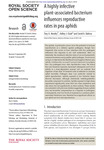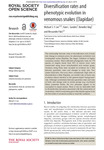Search
Now showing items 1-10 of 29
Discrete but variable structure of animal societies leads to the false perception of a social continuum
(2016)
Animal societies are typically divided into those in which reproduction within a group is monopolized by a single female versus those in which it is shared among multiple females. It remains controversial, however, whether ...
High atmospheric temperatures and ‘ambient incubation’ drive embryonic development and lead to earlier hatching in a passerine bird
(The Royal Society, 2016)
Tropical and subtropical species typically experience relatively high atmospheric temperatures during reproduction, and are subject to climate-related challenges that are largely unexplored, relative to more extensive work ...
Trophic niche divergence among colour morphs that exhibit alternative mating tactics
(2016)
Discrete colour morphs associated with alternative mating tactics are assumed to be ecologically equivalent. Yet suites of behaviours linked with reproduction can also favour habitat segregation and exploitation of different ...
Attack risk for butterflies changes with eyespot number and size
(2016)
Butterfly eyespots are known to function in predator deflection and predator intimidation, but it is still unclear what factors cause eyespots to serve one function over the other. Both functions have been demonstrated in ...
Evolutionary diversification of retinoic acid receptor ligand-binding pocket structure bymolecular tinkering
(2016)
Whole genome duplications (WGDs) have been classically associated with the origin of evolutionary novelties and the so-called duplication–degeneration–complementation model describes the possible fates of genes after ...
The easternmigratory caribou
(2016)
Understanding the evolutionary history of contemporary animal groups is essential for conservation and management of endangered species like caribou (Rangifer tarandus). In central Canada, the ranges of two caribou subspecies ...
Geographical variation in the heterogeneity of mutualistic networks
(2016)
Plant–animal mutualistic networks are characterized by highly heterogeneous degree distributions. The majority of species interact with few partner species, while a small number are highly connected to form network hubs ...
A highly infective plant-associated bacterium influences reproductive rates in pea aphids
(2016)
Pea aphids, A cyrthosiphon pisum, have the potential to increase reproduction as a defence against pathogens, though how frequently this occurs or how infection with live pathogens influences this response is not well ...
Comparative phylogenetic analyses uncover the ancient roots of Indo-European folktales
(2016)
Ancient population expansions and dispersals often leave enduring signatures in the cultural traditions of their descendants, as well as in their genes and languages. The international folktale record has long been regarded ...
Diversification rates and phenotypic evolution in venomous snakes
(2016)
The relationship between rates of diversification and of body size change (a common proxy for phenotypic evolution) was investigated across Elapidae, the largest radiation of highly venomous snakes. Time-calibrated ...










